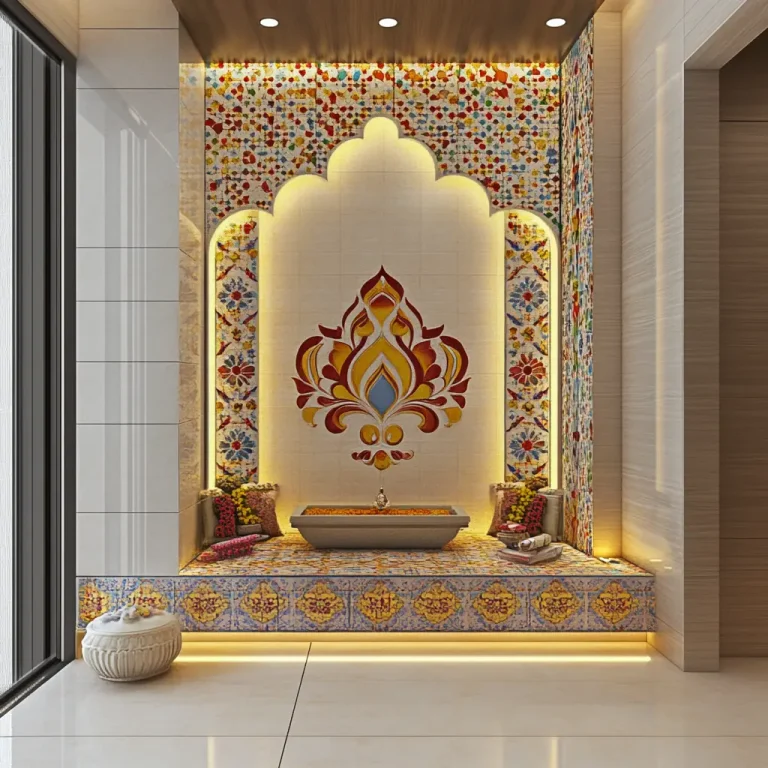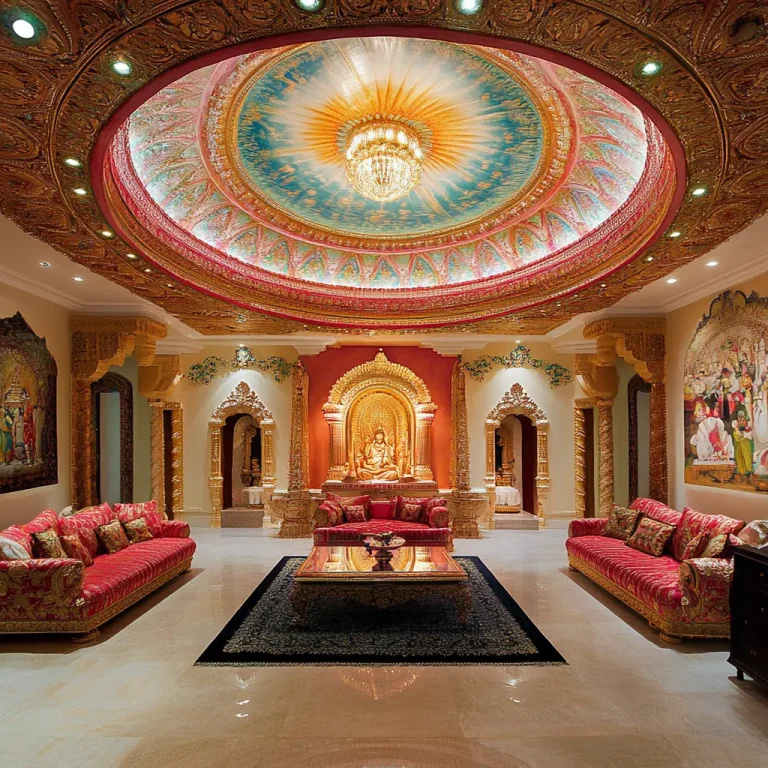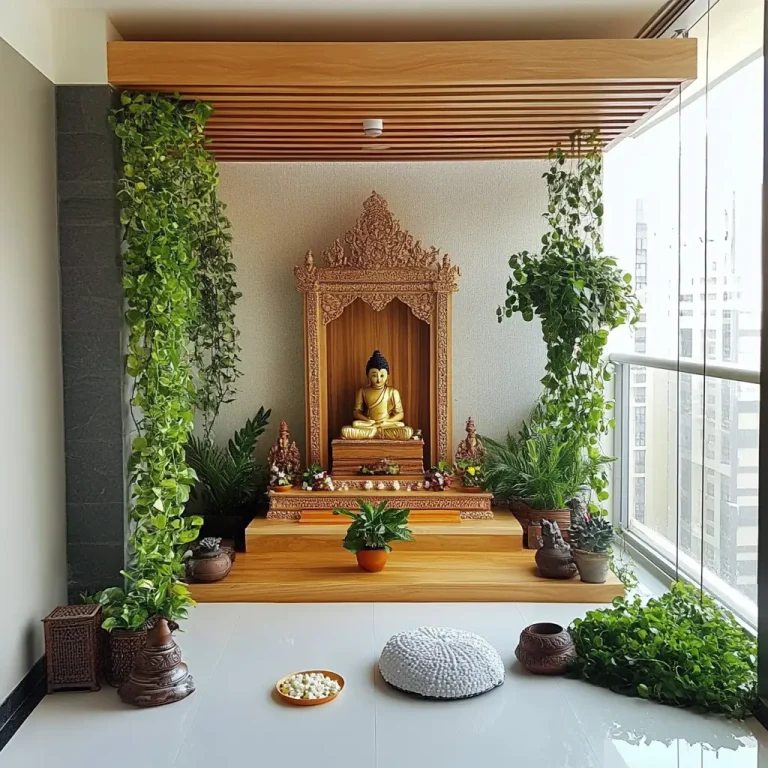25 Pooja Room Ideas Indian Homes Will Love
In Indian homes, the pooja room is more than just a spiritual corner—it is a place where tradition, peace, and personal devotion converge. Regardless of your home’s size or design, your pooja space can reflect both your faith and style. From luxurious temple-inspired spaces to minimalist wall units, here are 25 pooja room ideas tailored for modern and traditional Indian homes alike.
1. Traditional Wooden Mandir
A timeless choice, a carved wooden mandir brings warmth, beauty, and heritage into your pooja space. Crafted from rich woods like teak or rosewood, these mandirs often feature intricate carvings, domes, and decorative pillars that echo temple architecture. Pair it with brass bells and diyas for an authentic spiritual atmosphere.
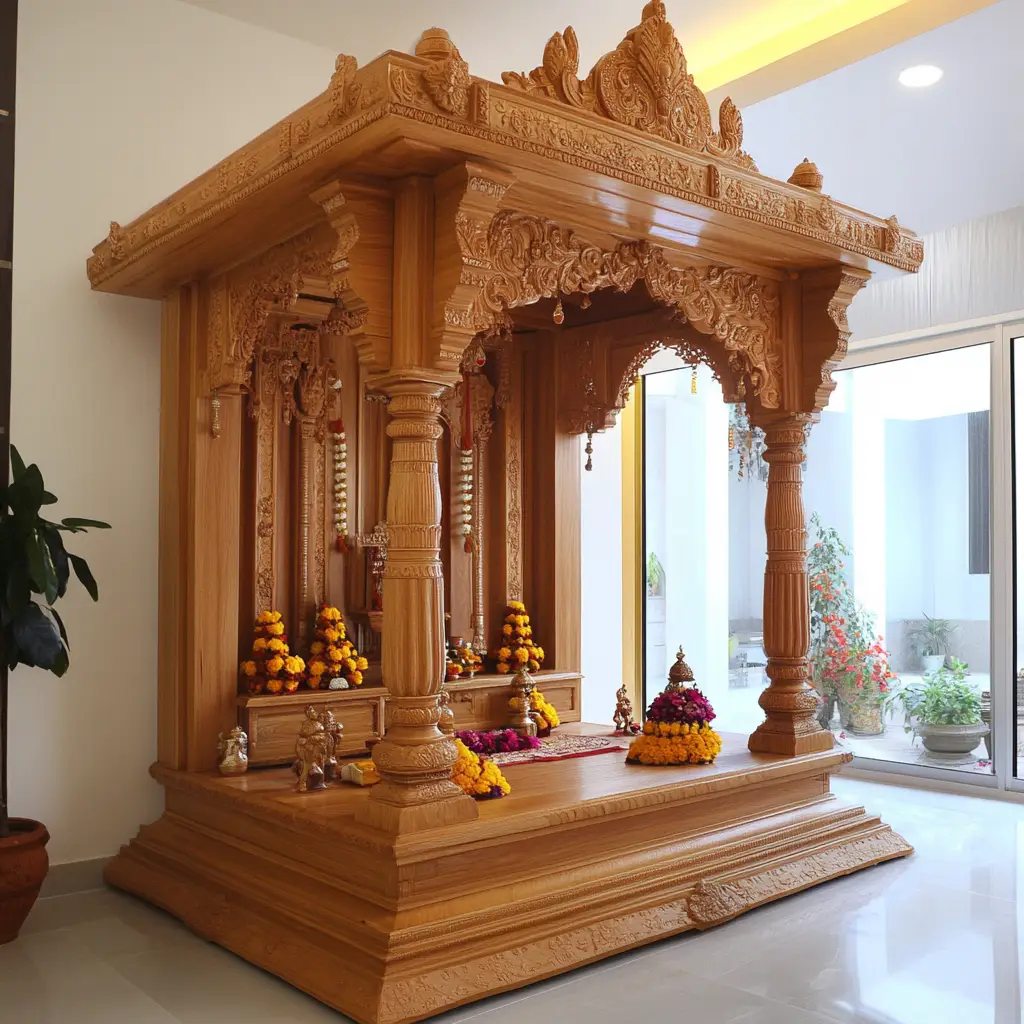
2. Wall-Mounted Pooja Unit
Ideal for compact urban homes, a wall-mounted mandir can save floor space while still offering a dedicated spot for your rituals. Opt for sleek wood or marble finishes, and incorporate drawers below for storing incense, prayer books, and essential items.
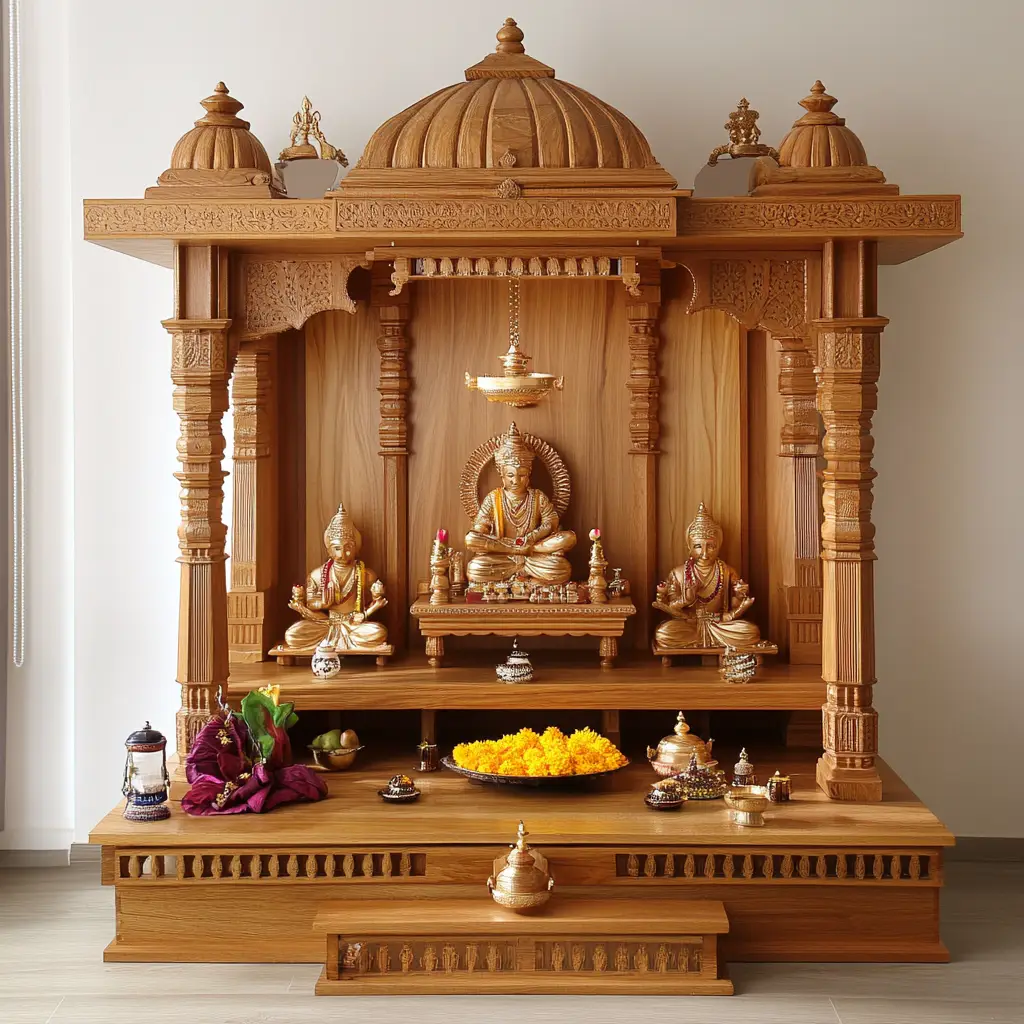
3. Marble Mandir Setup
Marble mandirs lend a luxurious and clean aesthetic. White marble in particular symbolizes purity and devotion. You can enhance this with soft LED lighting, golden inlays, or a subtle jaali pattern on the back wall. Marble also has the advantage of being durable and easy to maintain.

4. Temple-Style Architecture
Recreate a traditional South Indian temple feel in your home by designing your pooja room with miniature pillars, ornate ceilings, and granite or red oxide floors. Adding traditional brass oil lamps, bells, and tulsi pots can further evoke the feeling of visiting a temple.
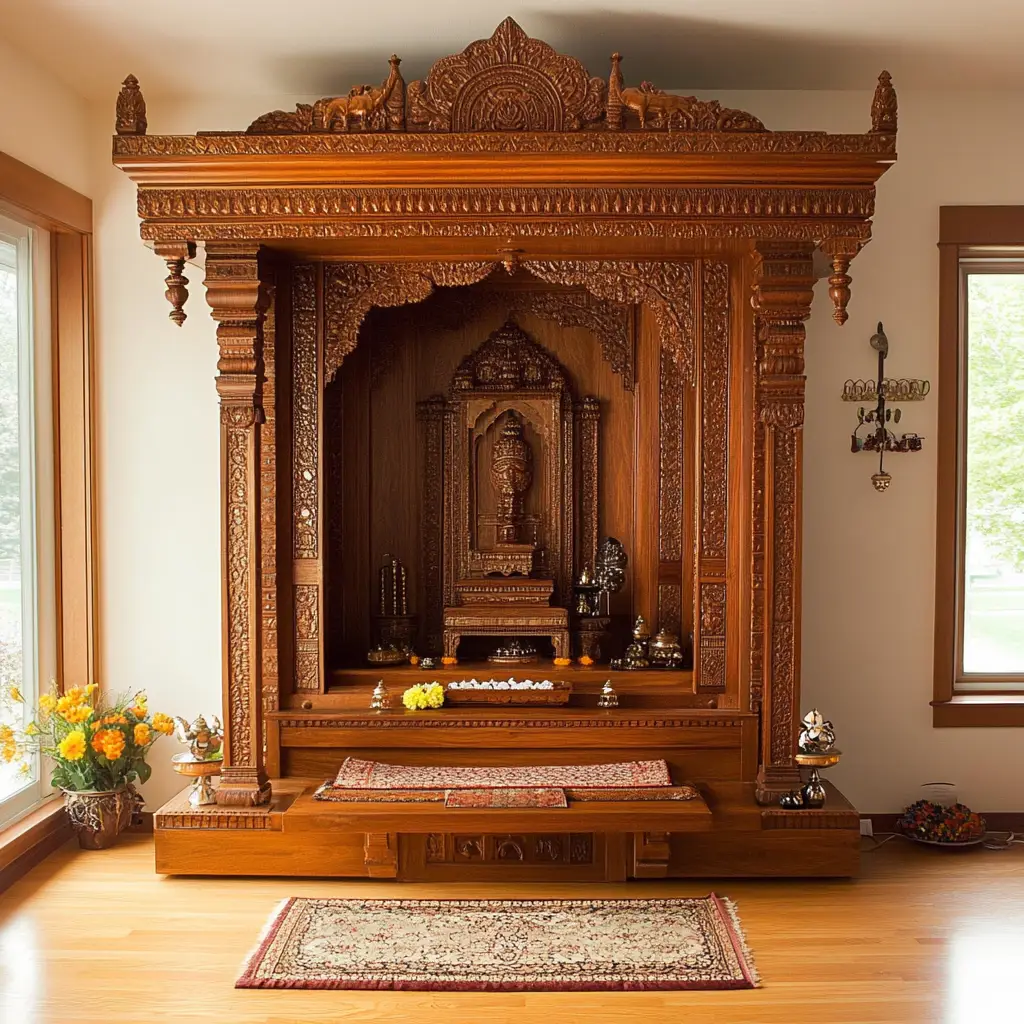
5. Glass-Enclosed Mandir
A glass-enclosed mandir is a modern solution for contemporary interiors. Use frosted or stained glass to create a sacred zone that maintains transparency while offering some privacy. It’s especially effective in open-plan homes where you want visual separation without full walls.
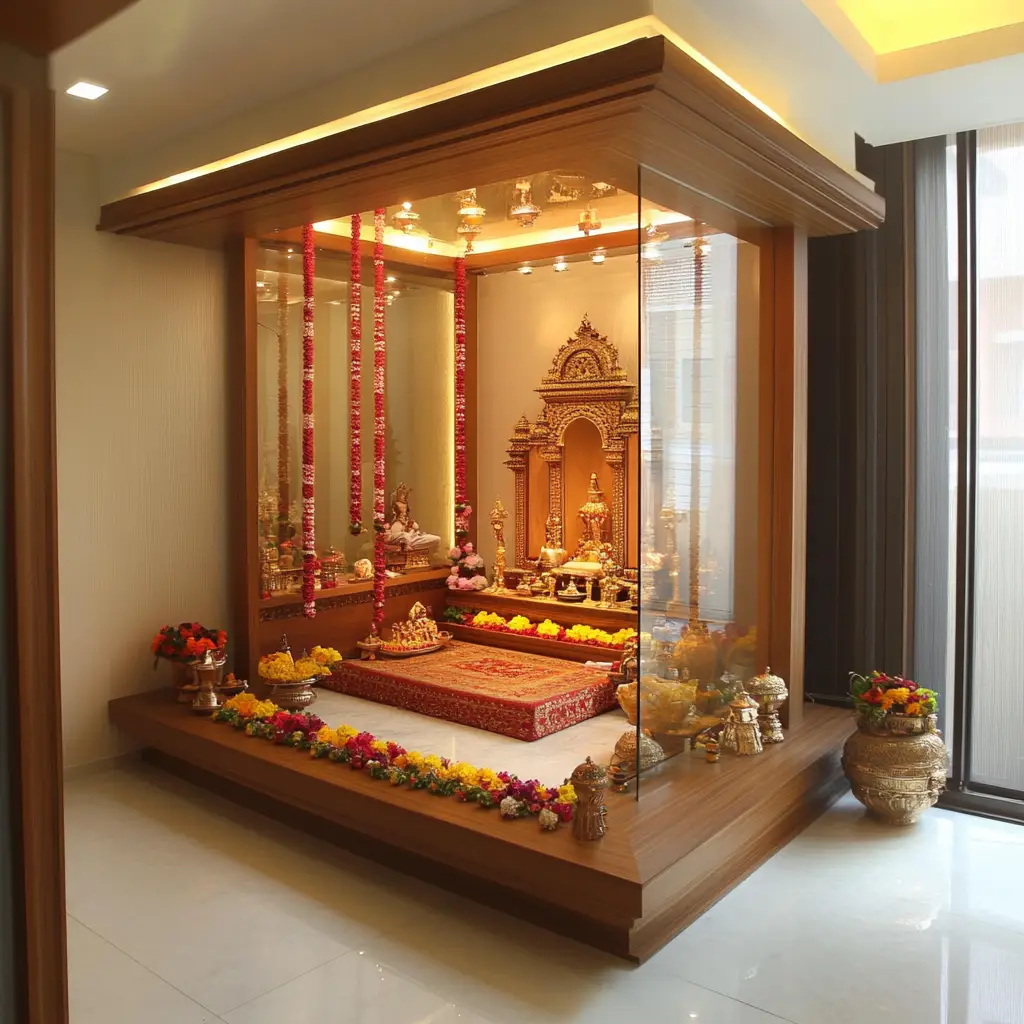
6. Pooja Room with Jaali Doors
Jaali or lattice doors are a beautiful and practical way to add ventilation and aesthetic charm. Made from wood, MDF, or metal, they create a play of light and shadow that enhances the sanctity of the space while ensuring it doesn’t feel closed off.
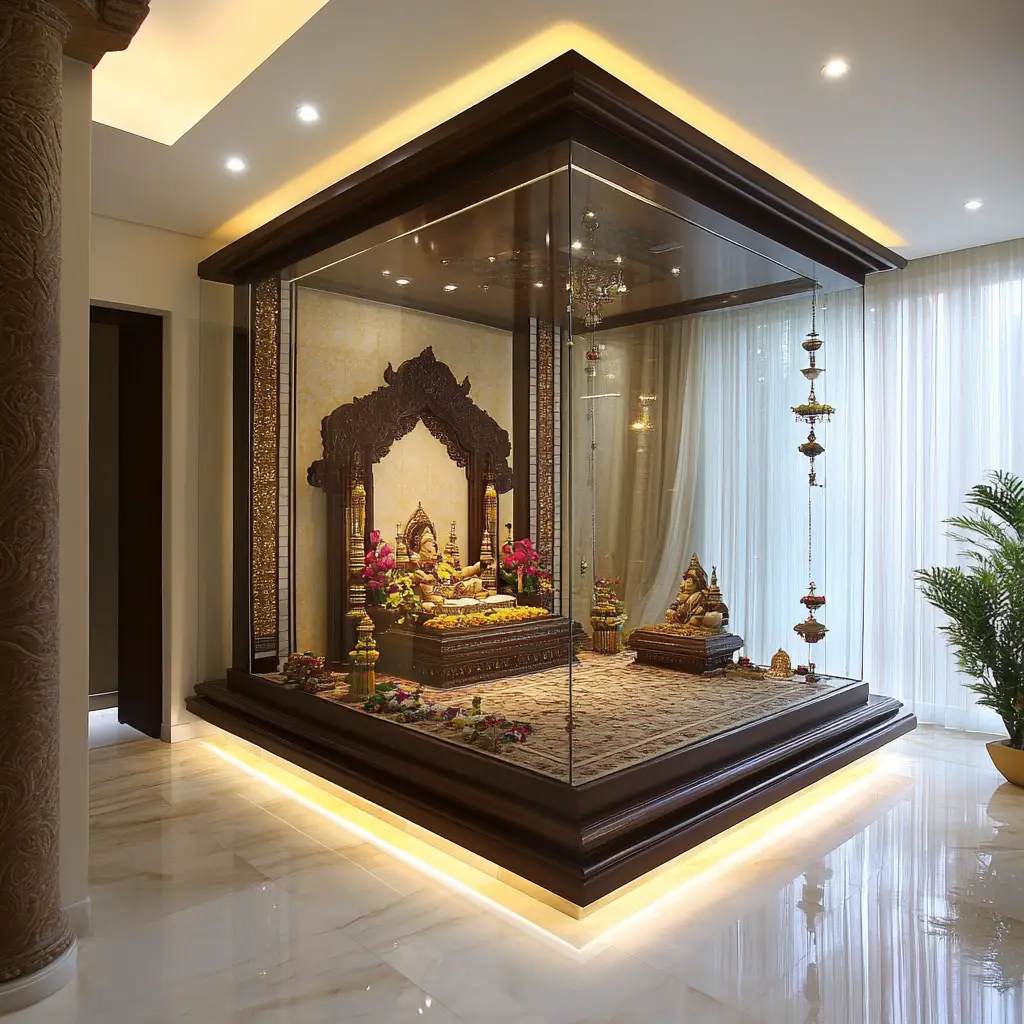
7. Floating Shelves for Idols
Minimalist and elegant, floating shelves are perfect if you want to keep your pooja area compact yet graceful. Choose marble or wood shelves and arrange idols and lamps in a tidy, symmetrical manner. It’s a clean look that works well in modern homes.
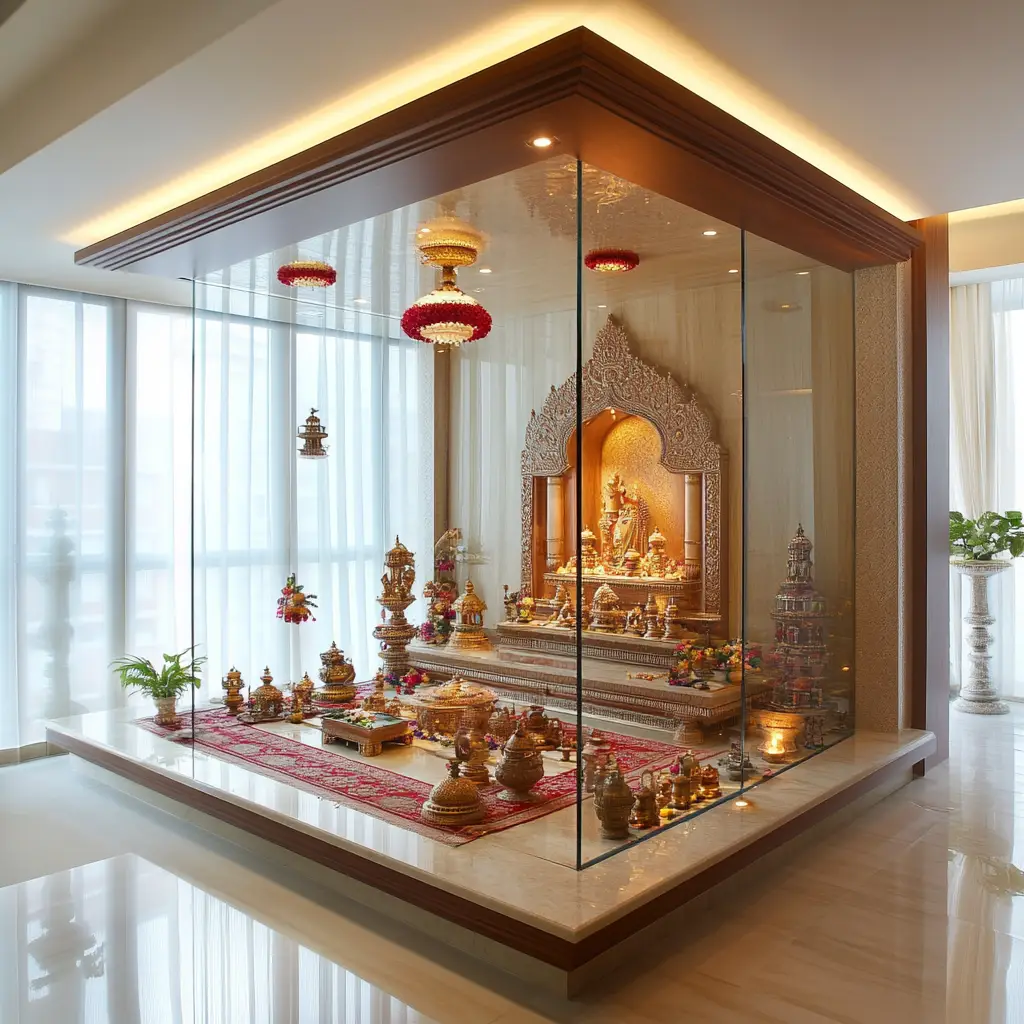
8. South Indian Brass Decor
Incorporating traditional South Indian elements like large brass diyas, bells, and urulis filled with flowers brings a rich cultural touch to your pooja room. This style pairs well with both wood and stone backgrounds and adds a festive feel to the space year-round.
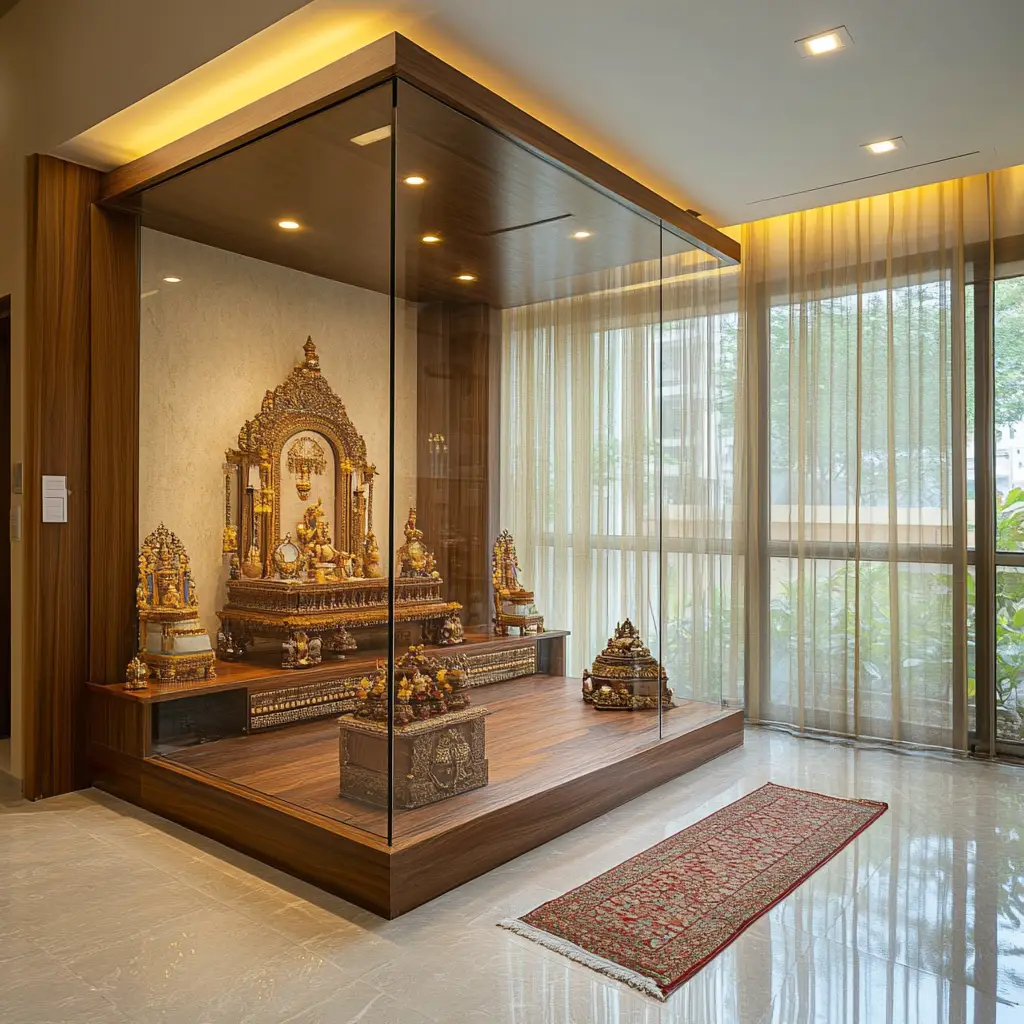
9. Corner Pooja Space
Don’t let limited space stop you—turn a quiet corner into a spiritual zone. A corner mandir with a low table, framed images or idols, and soft lighting can offer just as much tranquility as a full room. A small rug or cushion enhances the prayer experience.
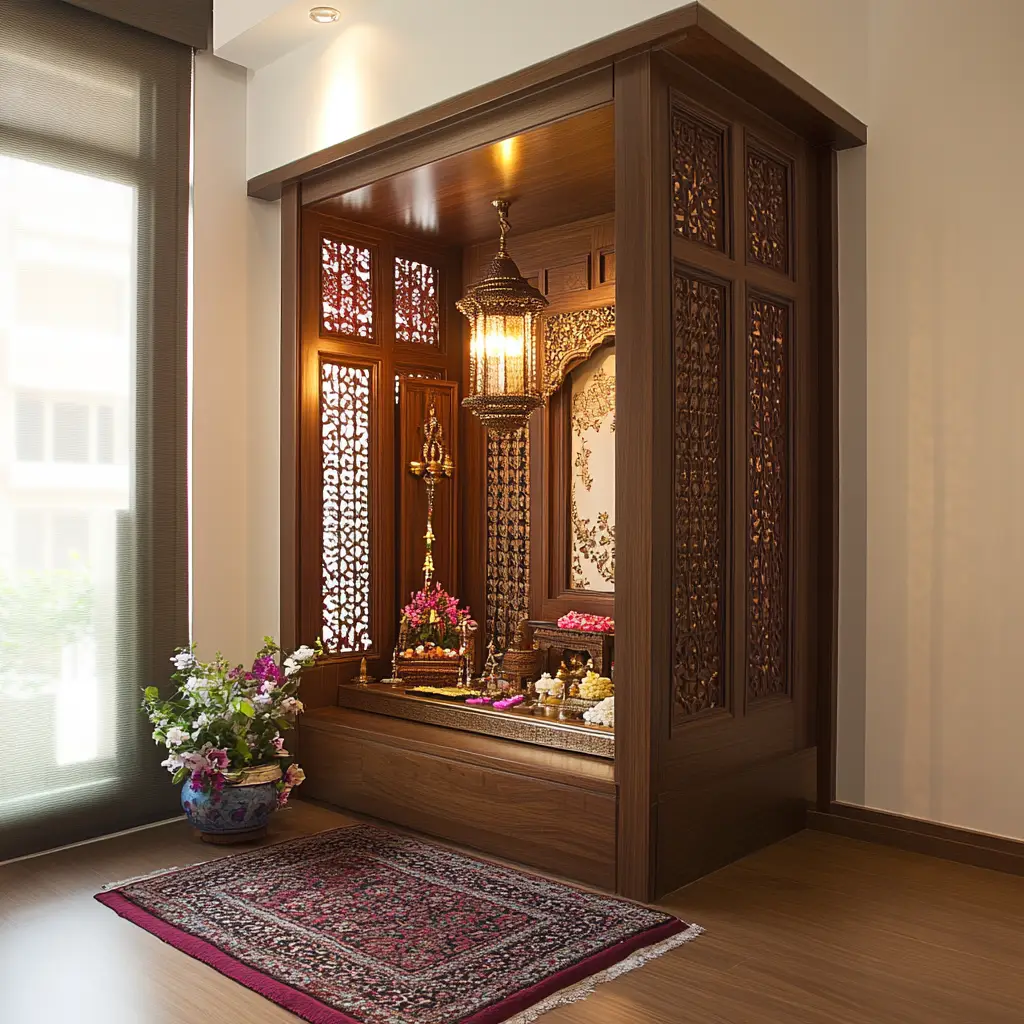
10. Backlit Panel Behind Idols
A backlit panel, often featuring motifs like Om, lotus flowers, or sacred geometry, adds depth and ambiance. This soft lighting draws attention to the idols while creating a warm glow that feels calming and sacred.
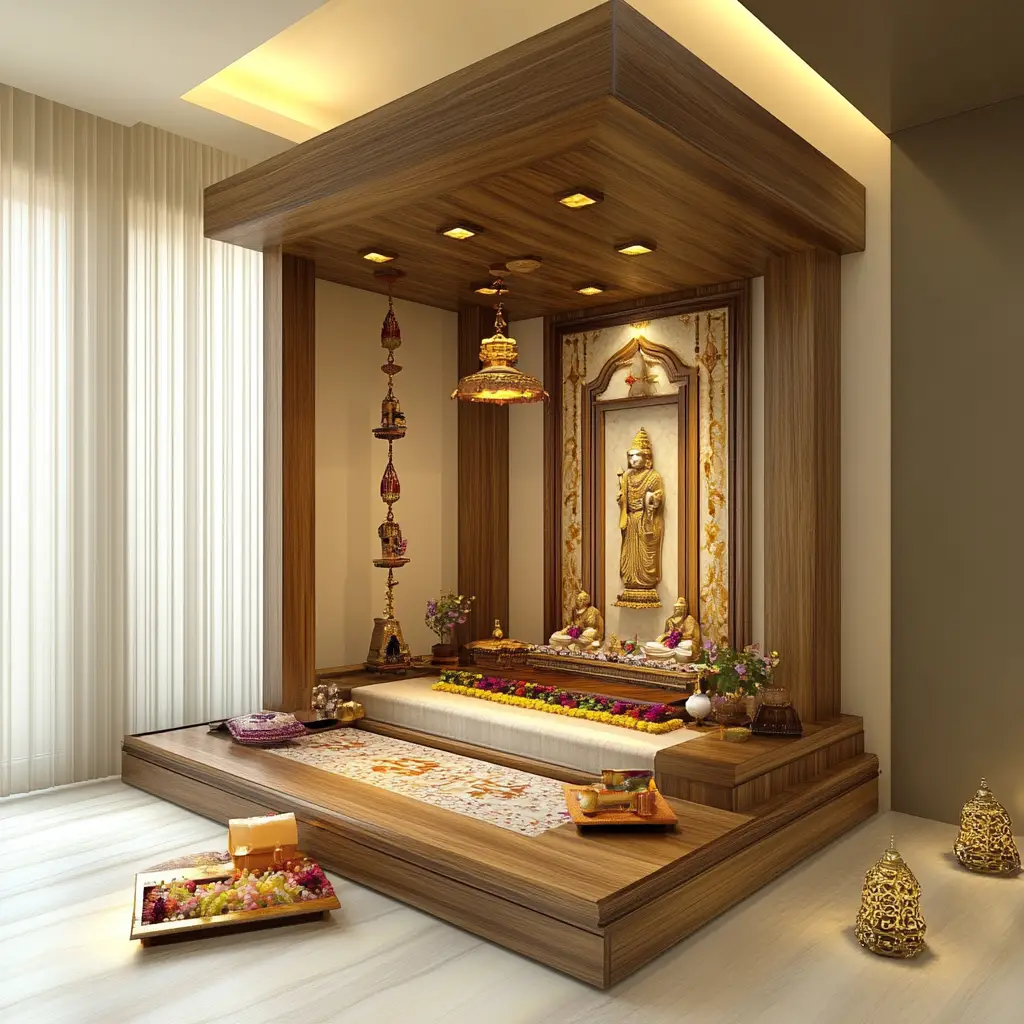
11. Gita or Vedas Display
Adding framed verses from the Bhagavad Gita or other scriptures not only decorates your space but also deepens the spiritual atmosphere. Consider using Sanskrit calligraphy or traditional paintings to personalize the walls.
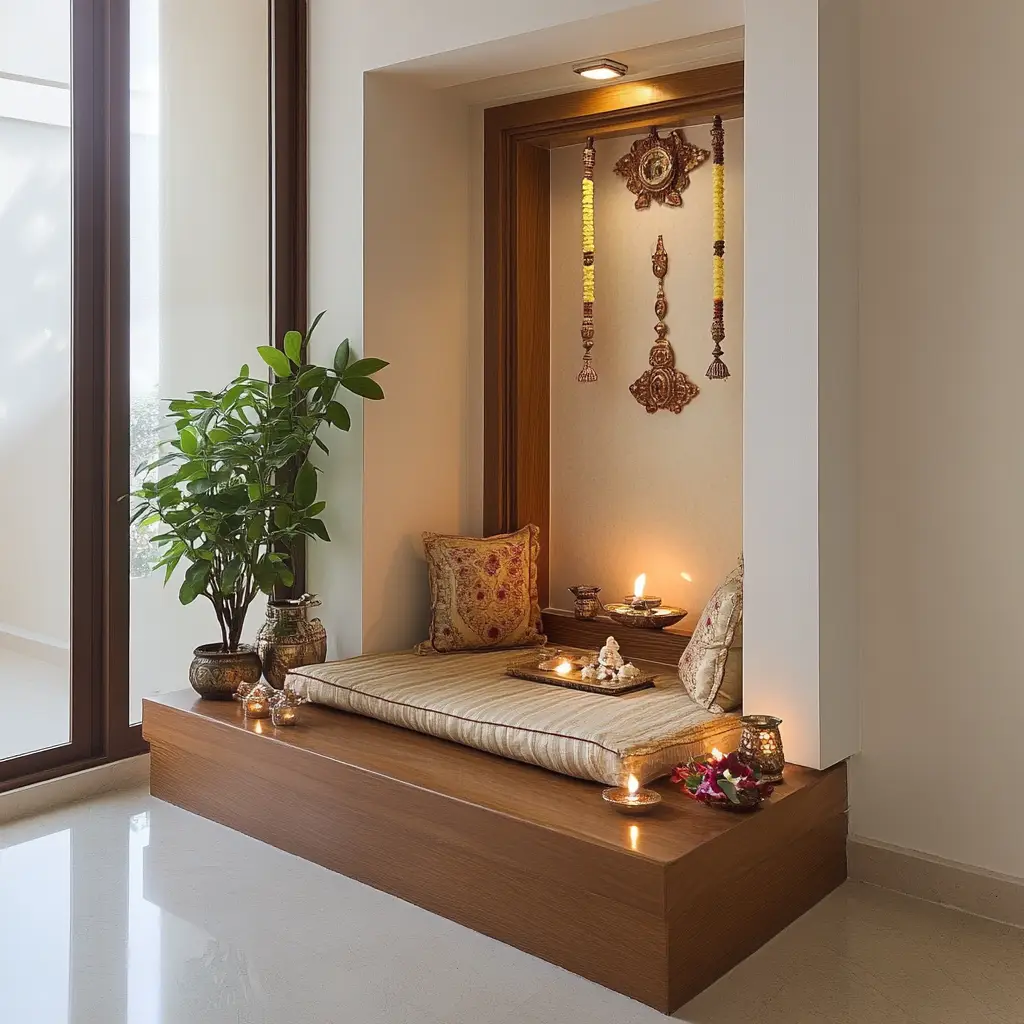
12. Temple Bell Installation
A brass or copper bell at the entrance of your pooja room adds both sound and symbolism. The ringing of the bell marks the start of worship and clears the mind. It’s a simple addition that enhances ritual and tradition.
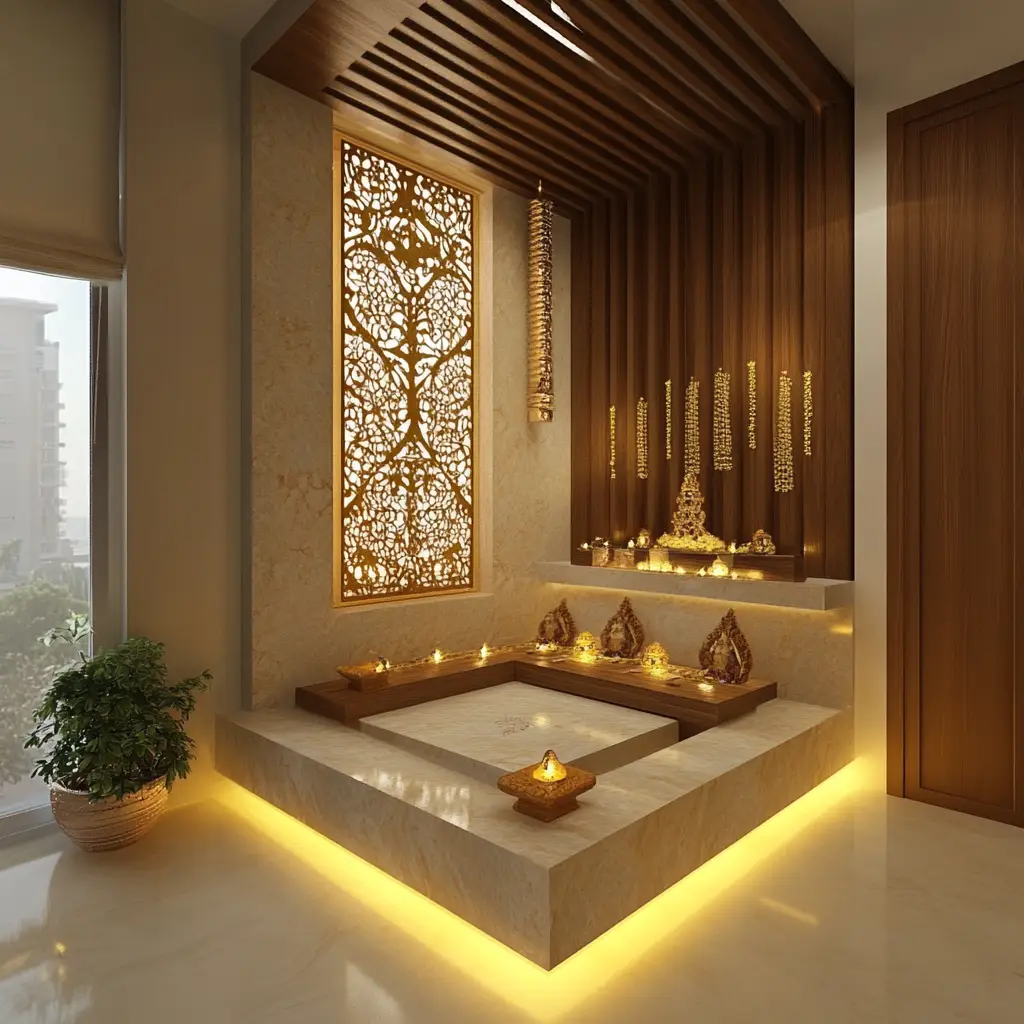
13. Compact Foldable Mandir
Foldable or portable mandirs are excellent for those who move often or have limited space. These designs typically come with fold-out doors, hidden storage, and can be tucked away when not in use. Despite their size, they can be beautifully detailed.

14. White and Gold Theme
If you’re aiming for an ethereal, peaceful look, a white and gold color palette can do wonders. White marble, golden idols or accents, and sheer curtains make the space feel divine and expansive, regardless of its size.
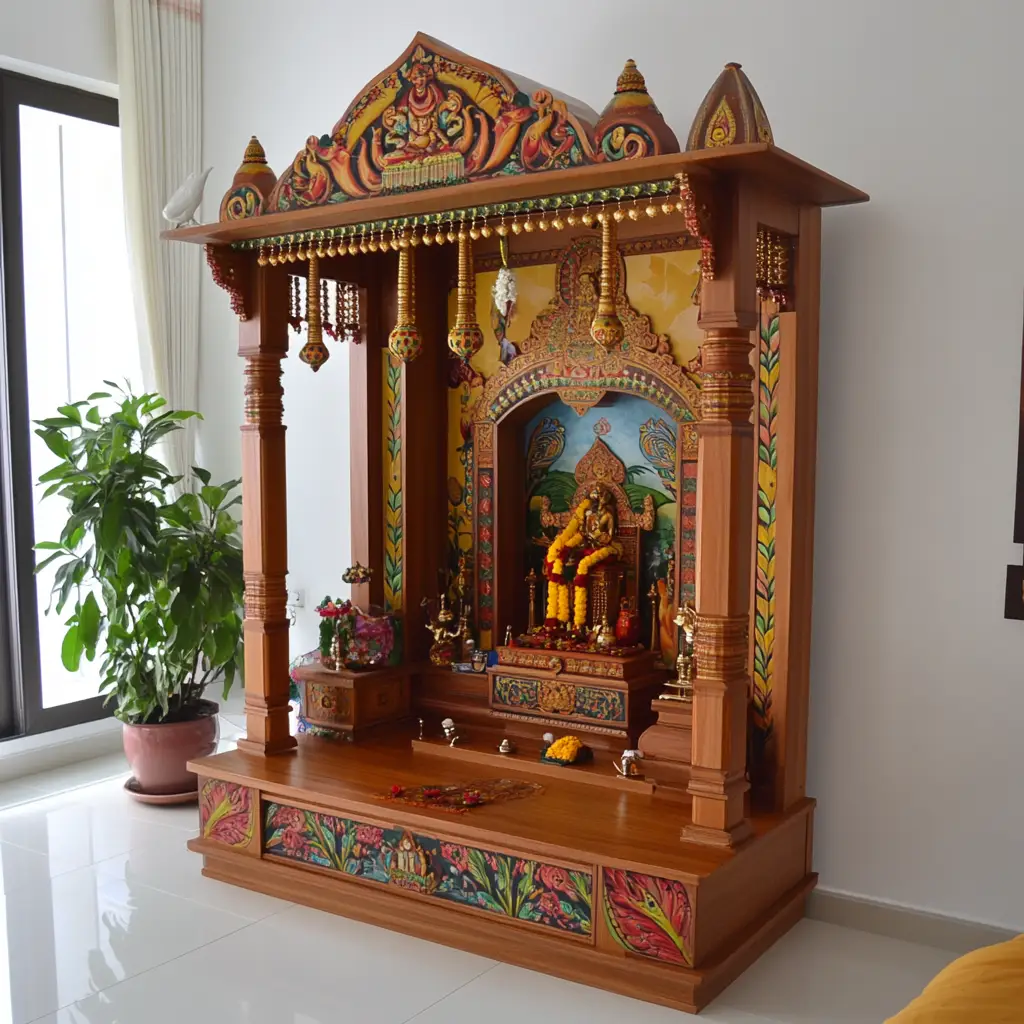
15. Niches in the Wall
Architectural niches or alcoves carved into the wall are elegant and space-saving. Add focused lighting within each niche to highlight individual idols. This approach blends modern minimalism with traditional reverence.
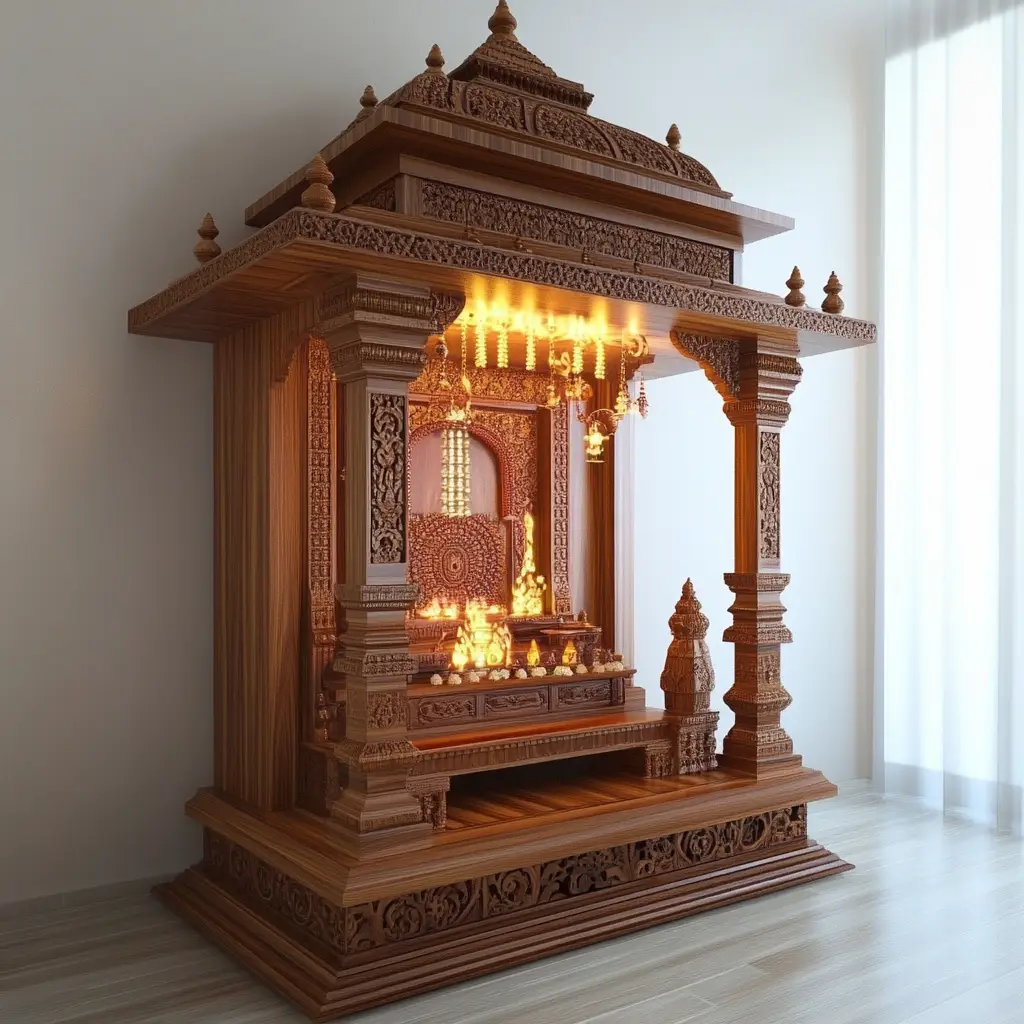
16. Pooja Room with Tulsi Plant
Placing a tulsi plant near or within your pooja area brings in natural elements and is considered highly auspicious. A small indoor planter with a tulsi plant, flanked by earthen lamps or terracotta decor, enhances the purity of the space.
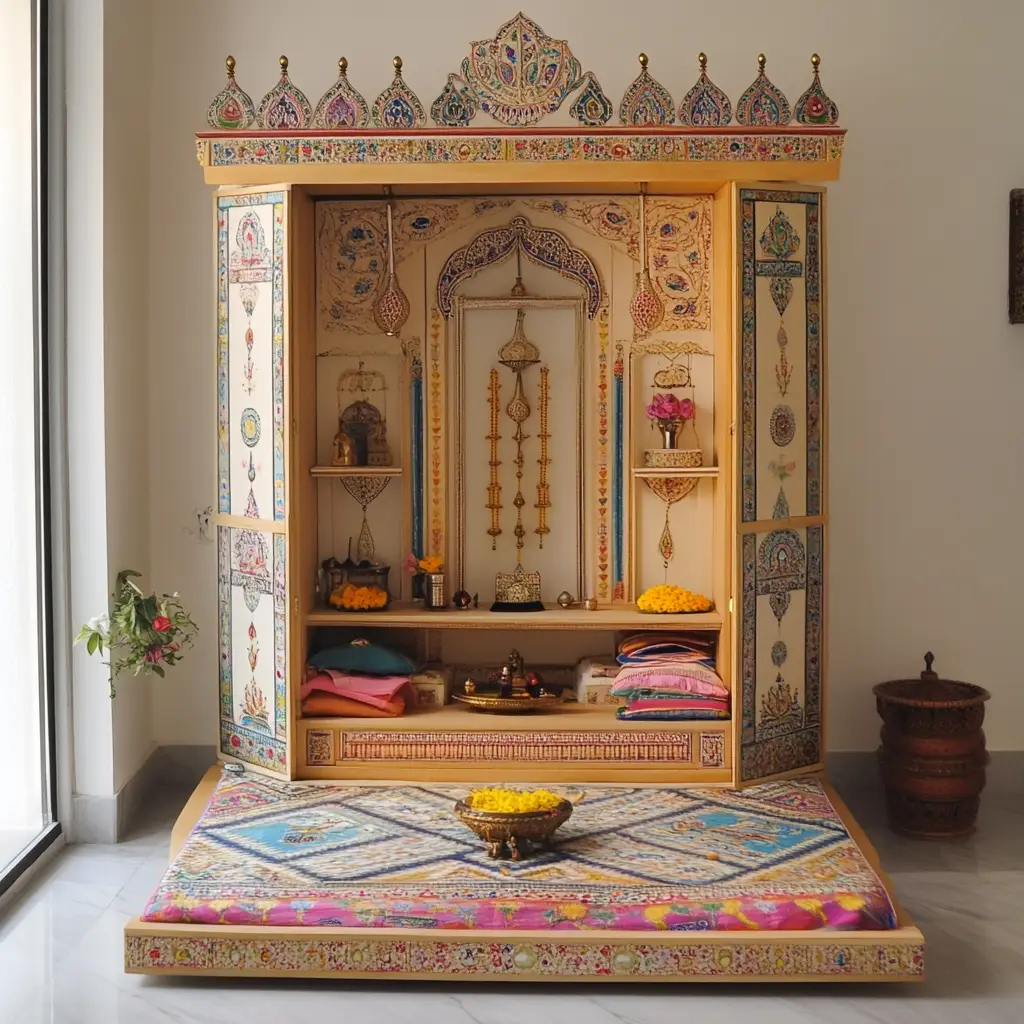
17. Hanging Diyas or Lamps
Instead of cluttering the altar, hang diyas or pendant lamps from the ceiling. They create visual interest while preserving surface space. Choose brass or antique-finished designs for a timeless look.

18. Ethnic Hand-Painted Backdrops
Add a colorful and artistic element to your pooja room with hand-painted murals or panels. Kalamkari, Madhubani, or Pattachitra styles lend cultural richness and personalize the space uniquely.
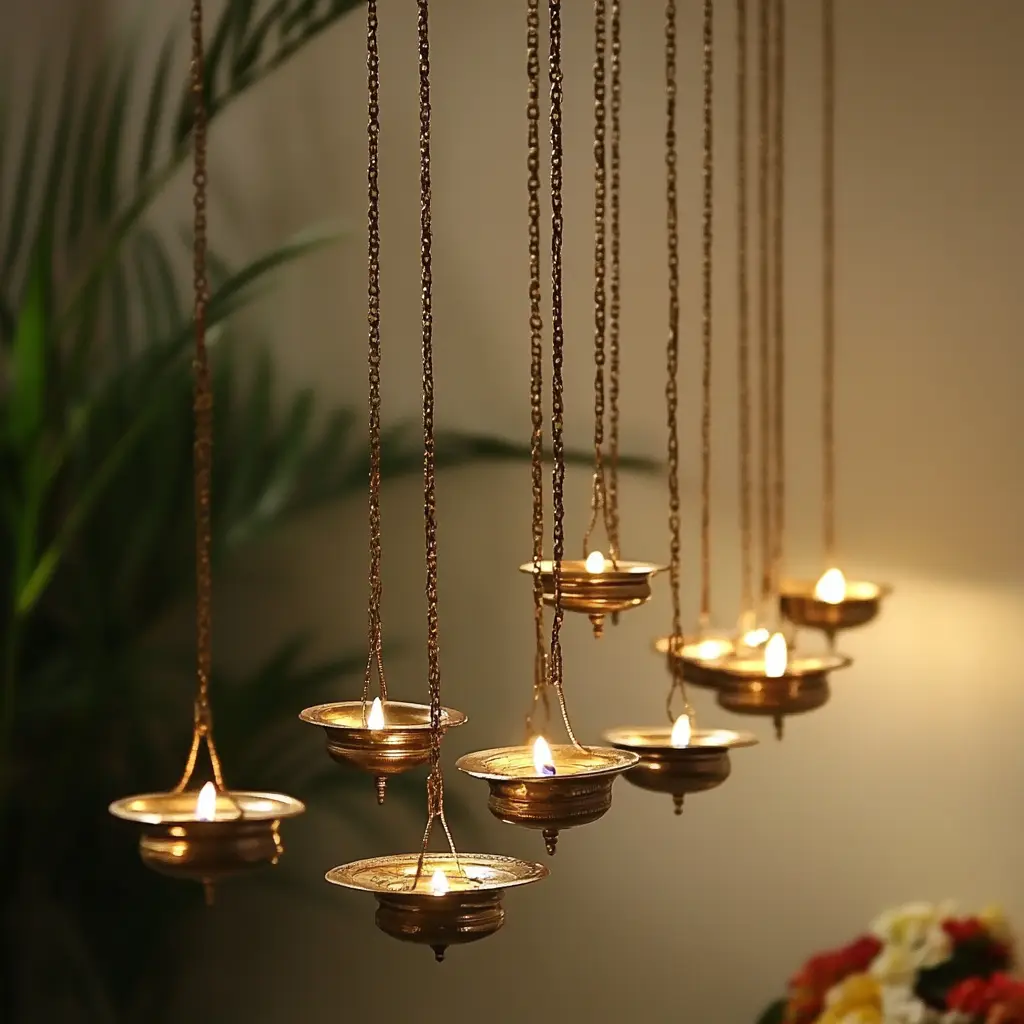
19. Granite Platform Setup
A black or grey granite platform is sturdy, easy to clean, and traditionally used in South Indian pooja rooms. Combine it with brass utensils and floor seating for an authentic and practical setup.
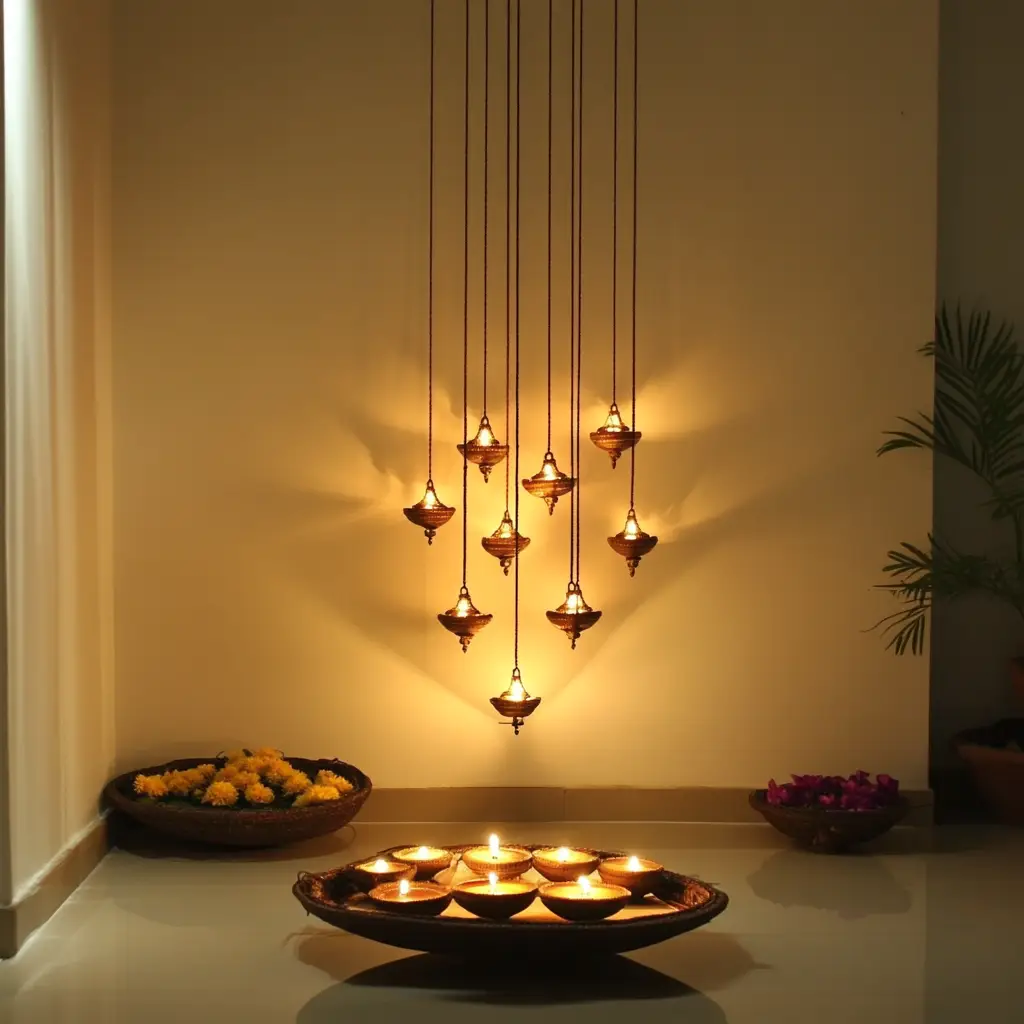
20. Carved Stone Mandir
Stone mandirs—crafted from soapstone, sandstone, or even marble—are visually stunning and offer temple-like gravitas. These work well in larger homes or as statement pooja corners in hallways.
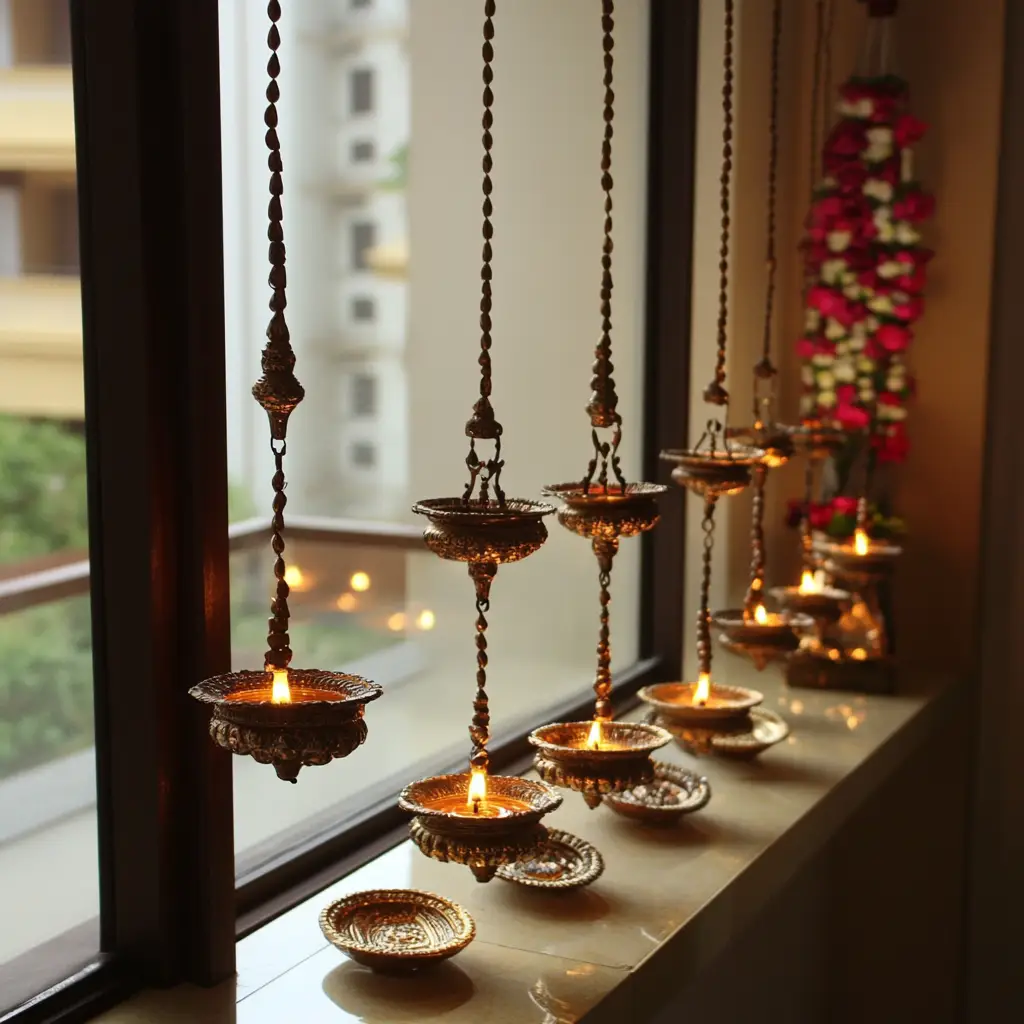
21. Wooden Pooja Room Partition
Use a wooden partition to define your pooja area in a shared space like the living or dining room. Choose a design with traditional motifs like bells, OM symbols, or floral carvings to maintain a spiritual vibe.
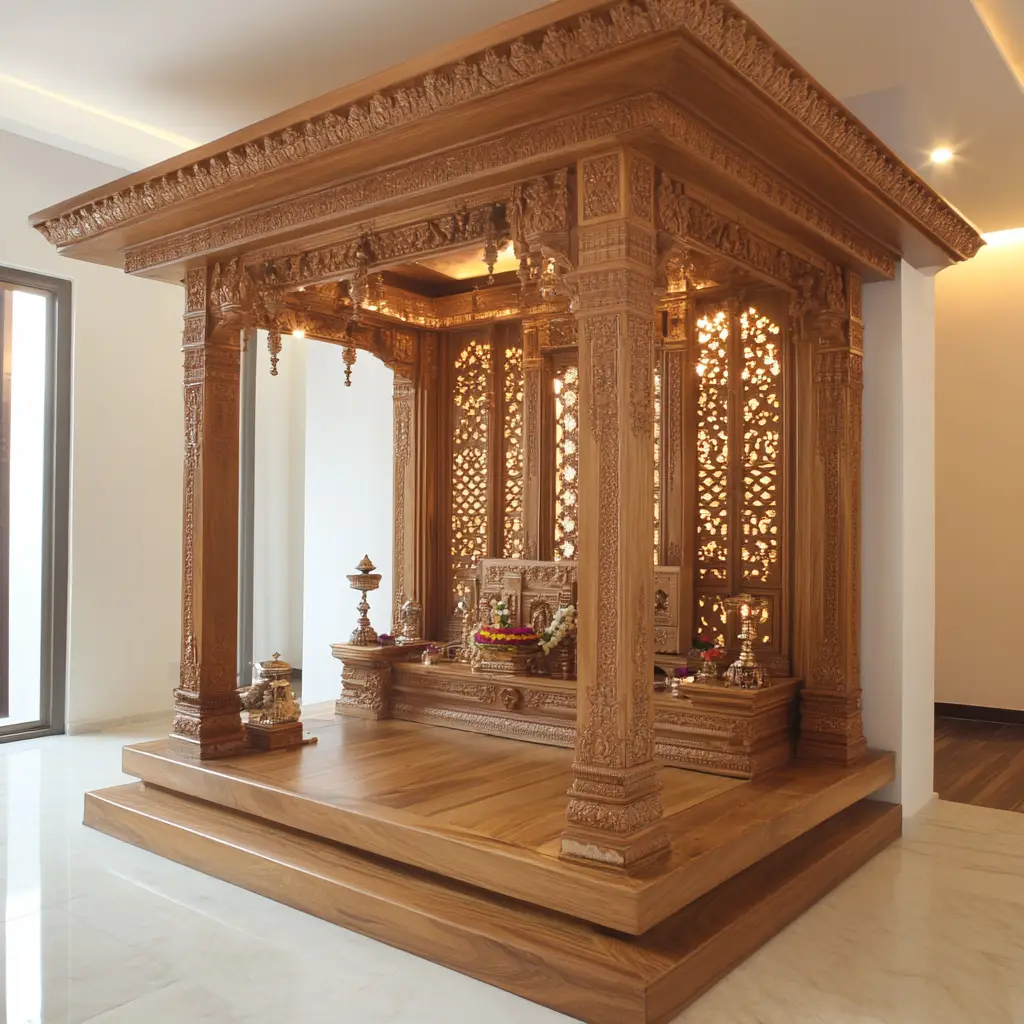
22. Floor Seating with Rugs
Place traditional dhurries or prayer mats near your altar for floor seating. Sitting on the ground during pooja creates a stronger connection with the space and invites calmness. Add a bolster or low cushion for comfort.
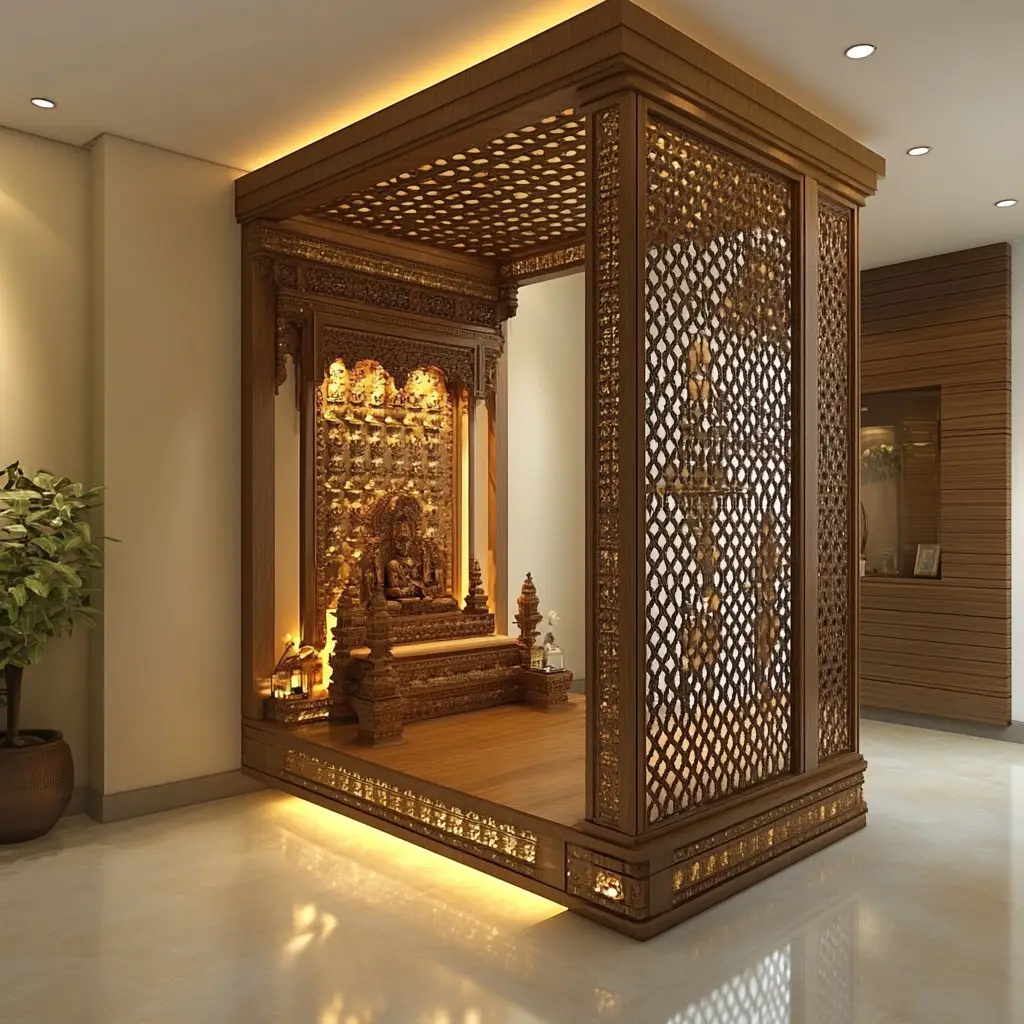
23. Idols in Brass or Clay
Opting for traditional materials like brass, terracotta, or eco-friendly clay for your idols not only looks beautiful but is also in line with Vastu and environmental values. These materials age gracefully and are easy to maintain.
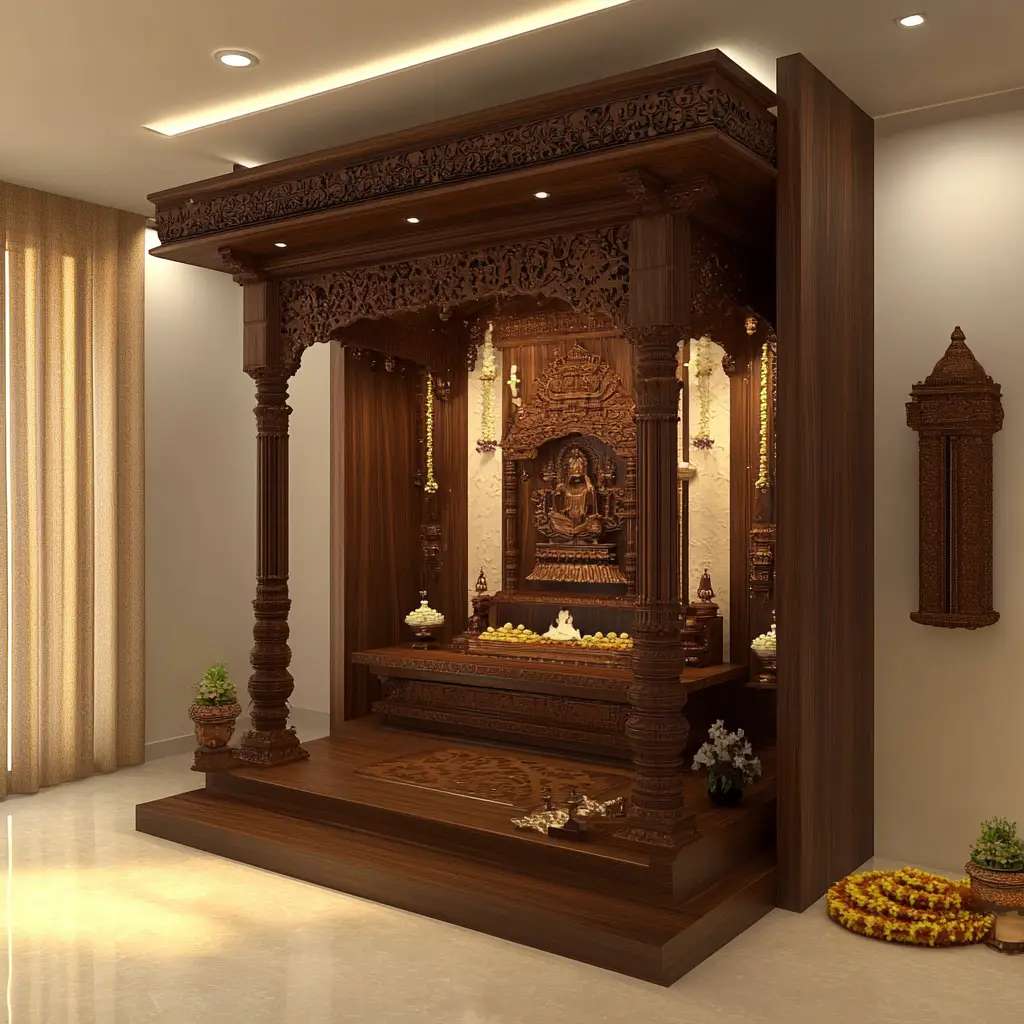
24. Illuminated Ceiling
Enhance the ceiling above your pooja room with backlighting or LED strips shaped like a lotus or OM. This subtle lighting elevates the divine atmosphere and adds architectural interest.
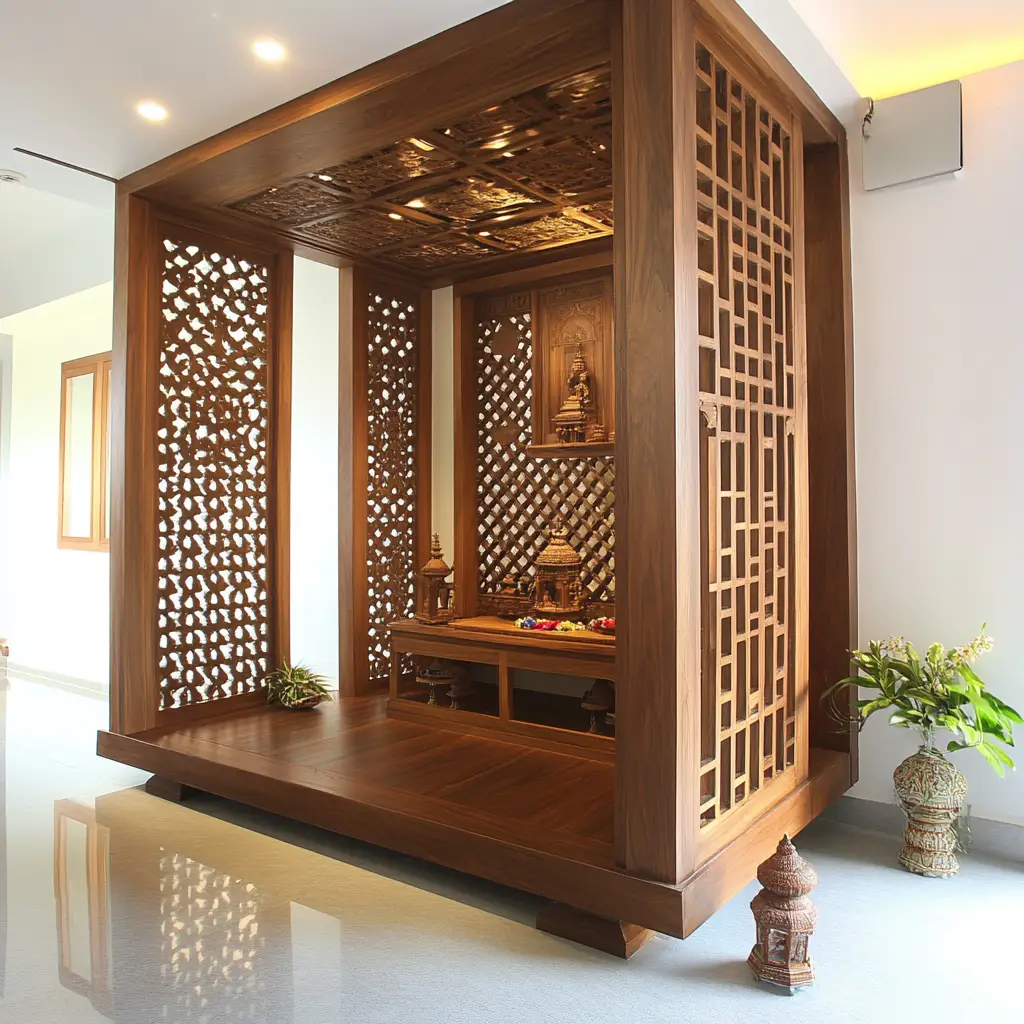
25. DIY Mandir with Personal Touch
If you’re on a budget or love personal projects, create your own mandir using reclaimed wood, old cabinets, or even a bookshelf. Decorate it with family photos, handmade torans, or embroidered cloths. It becomes a deeply personal and meaningful space.
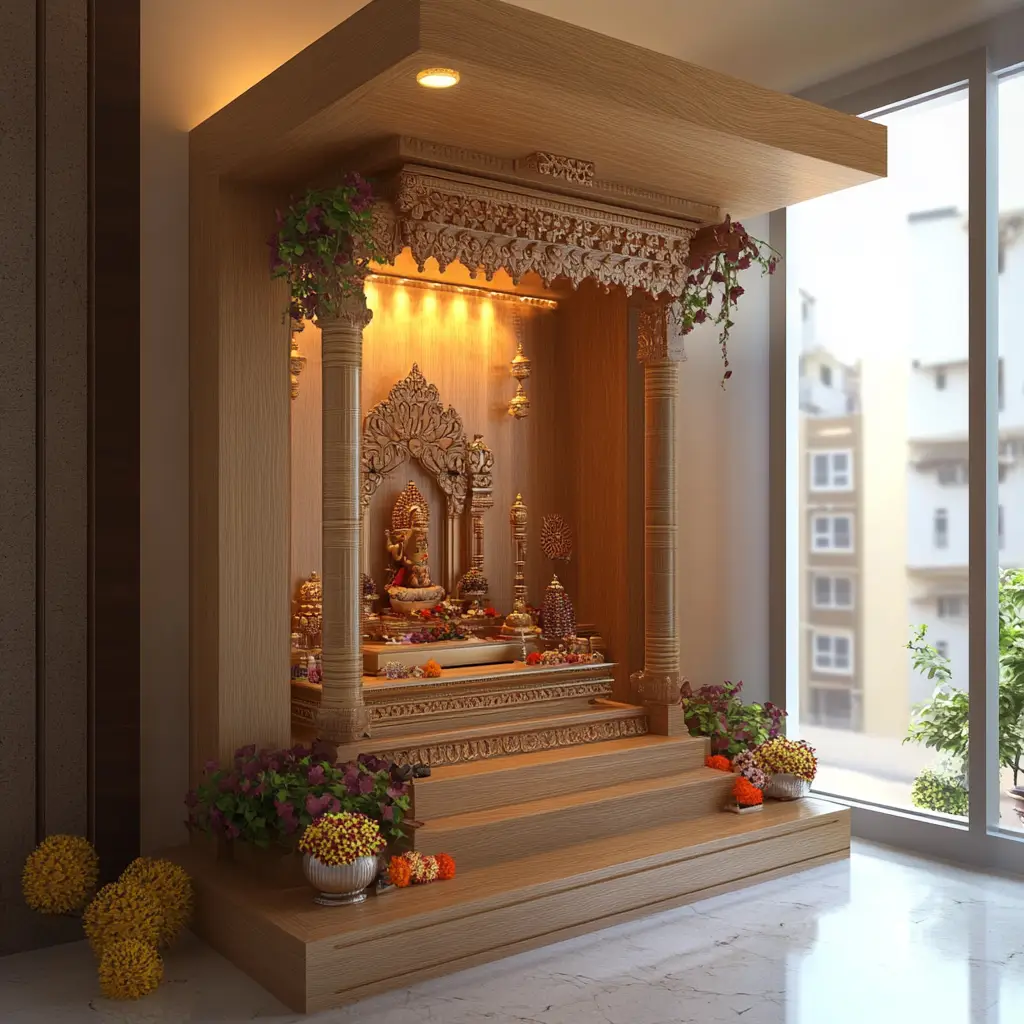
FAQs About Indian Pooja Room Designs
Where should the pooja room be located?
The northeast corner is considered the most auspicious as per Vastu Shastra. If that’s not possible, east or north directions are also suitable. Avoid placing the pooja space in bedrooms or bathrooms, as these spaces lack sanctity.
Can I have a pooja unit in the living room?
Yes, you can create a designated spiritual corner in your living room. Use partitions, jaali doors, or curtains to subtly separate it from the rest of the space while maintaining reverence.
Which materials are ideal for a pooja mandir?
Wood, marble, and granite are widely used. Brass and copper accents add traditional richness. For eco-conscious designs, clay and natural stone are great choices.
What should be avoided in pooja room design?
Avoid clutter, storage of unrelated items, or placing the unit below staircases or near washrooms. Keep the area clean, calm, and focused solely on worship.
How do I maintain a small pooja room?
Use drawers for storage, opt for fewer idols, and maintain regular cleaning. Soft lighting, a small mat, and a few fragrant elements like incense or flowers go a long way in enhancing the energy.
Conclusion
Creating a pooja room is a deeply personal journey—one that brings together your beliefs, heritage, and home environment. Whether you prefer traditional wooden mandirs or contemporary marble shelves, the essence lies in making a space that encourages calm, devotion, and positivity. With thoughtful planning and a little creativity, you can design a sacred nook that brings blessings and peace into your everyday life.
